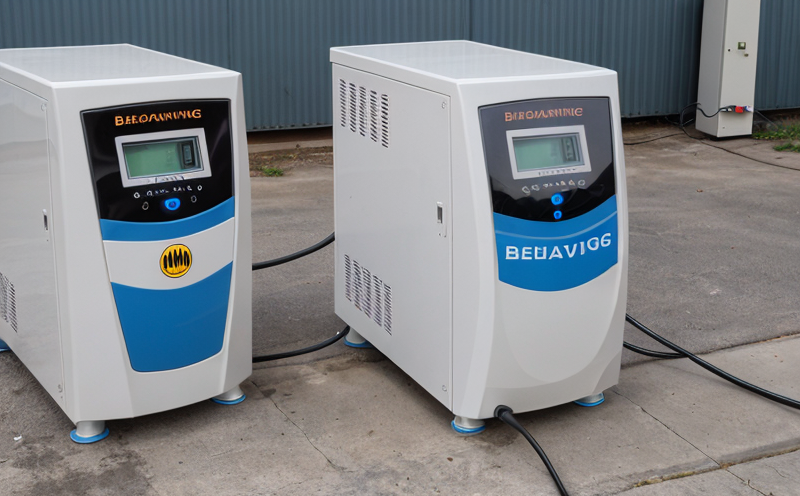GB/T 34013 Charging and Discharging Behavior Testing of Lithium-Ion Batteries at Low Temperatures
The testing of lithium-ion batteries under low temperature conditions is critical in ensuring the reliability, safety, and performance of these batteries across various sectors such as automotive, aerospace, and consumer electronics. GB/T 34013 specifies the procedures for charging and discharging behavior tests of lithium-ion batteries at temperatures below -20°C. This test is essential for quality assurance and compliance with international standards.
The process involves subjecting the batteries to controlled temperature environments followed by precise charging and discharging cycles under defined conditions. This allows manufacturers, researchers, and quality control personnel to assess how well a battery performs when subjected to extreme cold weather conditions. Understanding these behaviors is crucial for optimizing battery design, improving performance, and ensuring safety.
The test provides insights into the battery's capacity retention, internal resistance changes, and overall stability at low temperatures. It helps in identifying potential weaknesses or issues that may arise under such conditions, which can then be addressed during product development. This ensures that the final products meet not only functional requirements but also stringent safety standards.
The importance of this test cannot be overstated, especially for devices like electric vehicles (EVs) and portable electronics where operational efficiency at low temperatures directly impacts user experience and device lifespan. By adhering to GB/T 34013, manufacturers can ensure their products perform consistently across diverse climatic conditions.
Our laboratory uses state-of-the-art equipment calibrated according to industry best practices to conduct these tests accurately and reliably. Our experienced technicians follow strict protocols outlined in the standard to provide clients with comprehensive reports that meet both internal quality assurance needs as well as external regulatory requirements.
Scope and Methodology
| Test Parameters | Description |
|---|---|
| Temperature Range | Below -20°C |
| Charging and Discharging Cycles | Defined according to GB/T 34013 |
| Battery Type | Lithium-Ion Batteries |
| Data Collection | Continuous monitoring of voltage, current, and temperature during charging and discharging. |
The test begins by placing the lithium-ion batteries in a controlled environment set to the specified low temperature. The batteries are then charged according to predefined protocols until they reach full capacity. Afterward, the batteries undergo discharge cycles under similar conditions to simulate real-world usage scenarios. Throughout this process, continuous monitoring of key parameters ensures accurate data collection.
Data collected during these tests is analyzed using sophisticated software tools designed specifically for battery performance evaluation. This analysis helps in identifying any discrepancies between expected and actual results, providing valuable feedback for improvement. The final report includes detailed insights into the performance metrics of each battery tested, along with recommendations for enhancing future designs or modifications needed based on test outcomes.
Why Choose This Test
- To ensure reliable performance in cold climates.
- To comply with international standards and regulatory requirements.
- To identify potential issues early in the development stage.
- To optimize battery design for better efficiency at low temperatures.
- To enhance safety by detecting any vulnerabilities under extreme conditions.
- To provide detailed reports that meet both internal quality assurance needs as well as external regulatory standards.
Choosing this test is advantageous because it offers a comprehensive evaluation of how lithium-ion batteries behave in cold environments. This knowledge is invaluable for manufacturers aiming to produce robust, safe, and efficient products capable of performing optimally regardless of ambient temperature variations.
Quality and Reliability Assurance
The quality assurance process associated with GB/T 34013 includes several steps designed to ensure accuracy, consistency, and reliability of test results. Firstly, all equipment used in conducting these tests is regularly calibrated against known standards to maintain precision and accuracy. Secondly, trained personnel perform the tests following strict protocols outlined in the standard to minimize human error.
Data collected during each test cycle undergoes rigorous validation checks before being incorporated into final reports. These checks include cross-referencing results with previous data sets, comparing findings against theoretical models where applicable, and reviewing statistical outliers for potential errors or anomalies.
In addition to technical aspects, our team also focuses on ensuring compliance with relevant regulations and guidelines established by governing bodies worldwide. By adhering strictly to these rules, we guarantee that all test outcomes are valid, reliable, and meet necessary certification criteria.





